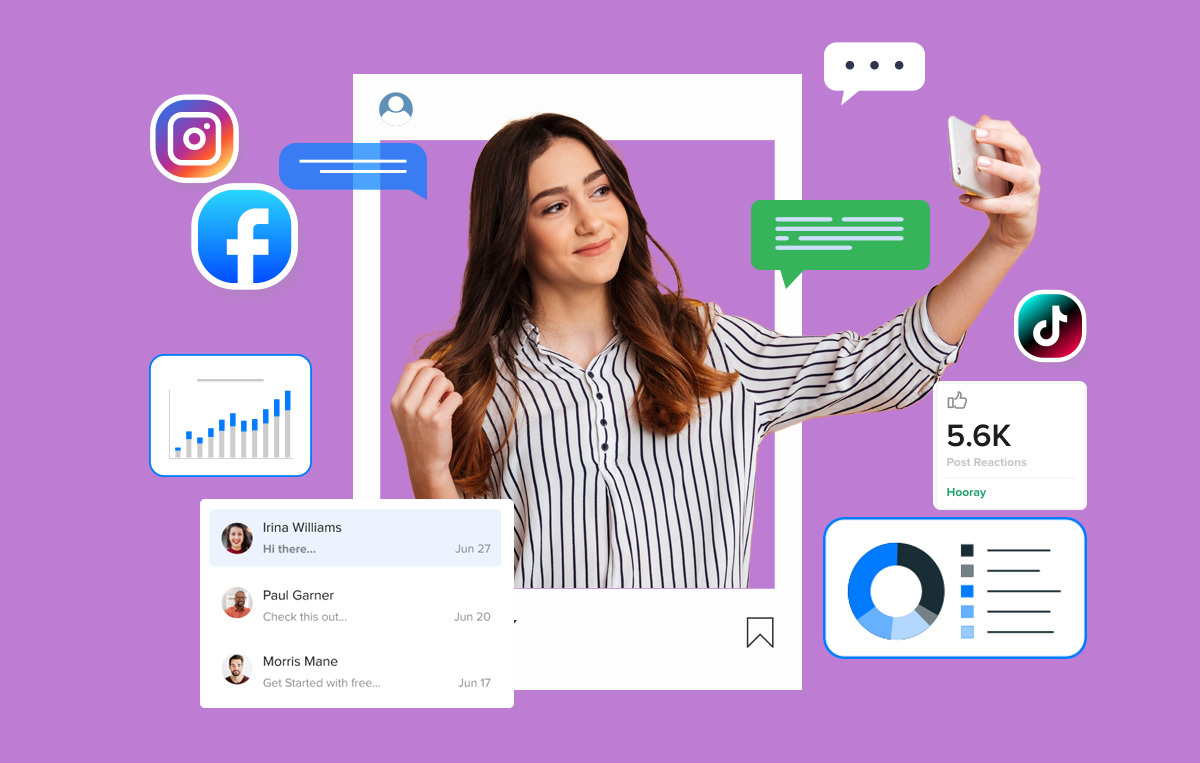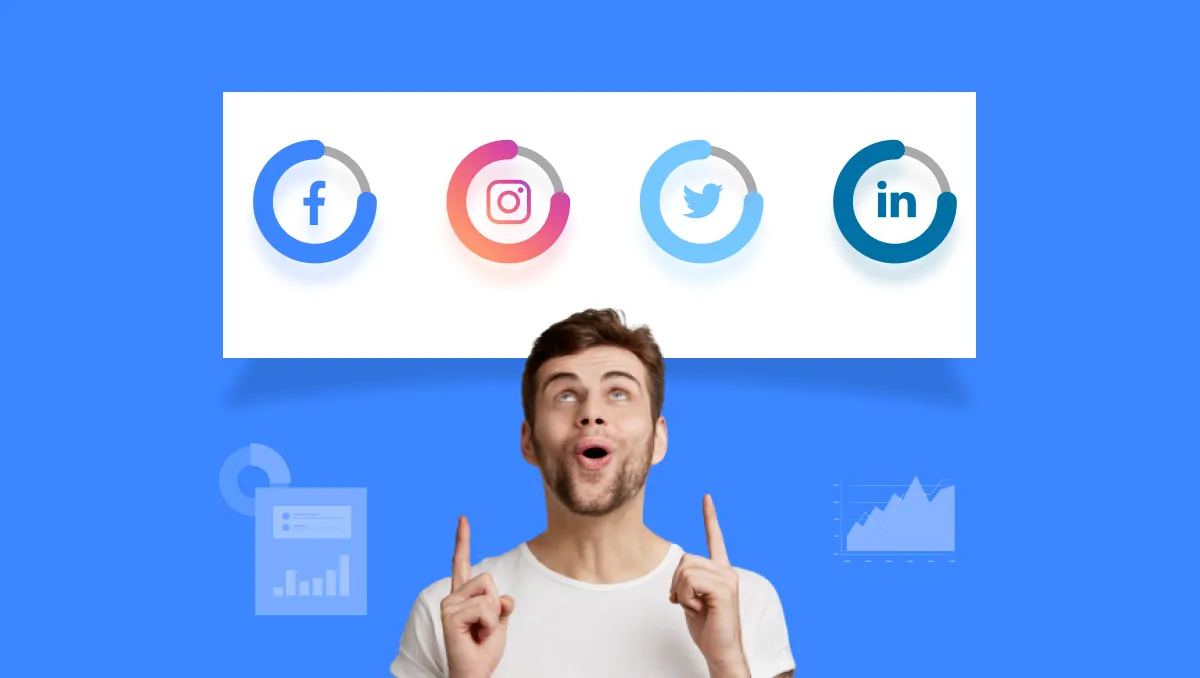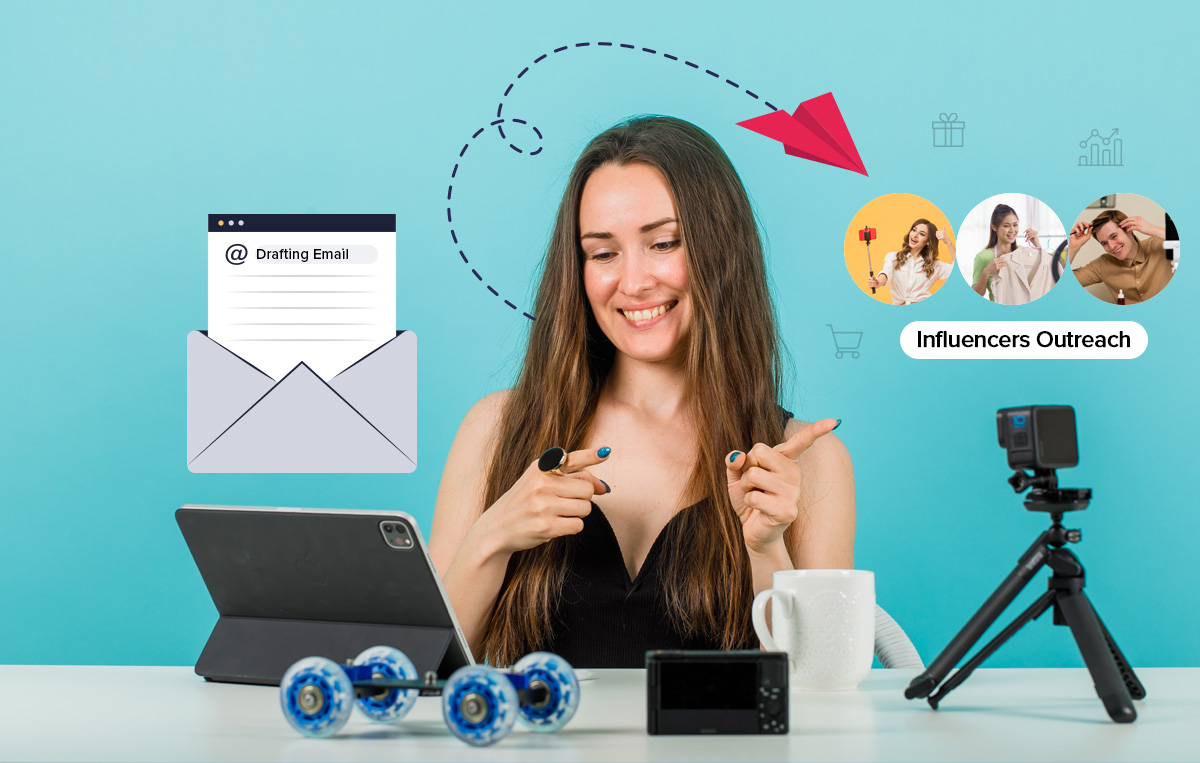Imagine you have the keys to a powerful marketing channel that boosts authenticity, expands reach, and drives engagement. Enter “Influencer Marketing,” an effective way to reach your target audience and generate leads.
In this competitive social media generation, authenticity and engagement are the two alphas of the game. Influencer marketing is the bridge to building trust, expanding your reach, and driving conversions like never before. As a marketer or a brand, you understand the power of data, and that’s precisely what this resource offers.
A complete list of Influencer marketing statistics, from engagement rates to industry benchmarks to growth trends; this blog has almost everything that you would need to make an informed decision. Whether you’re a seasoned pro or someone who is just getting started with influencer marketing, these statistics will be your guiding star, showing you the path to success.
General Influencer Marketing Statistics
If you choose to go the influencer marketing way, you should keep up with the latest trends and statistics that define the industry. Let’s start with general statistics and trends to give you a wide overview of the industry:
1. Global Spending on influencer marketing has increased to USD $34.08 billion
With the rapidly increasing popularity and efficiency attached to influencer marketing, it is not strange that global spending on influencer marketing amounted to approximately $34.08 billion USD in 2023. It truly reflects how many brands worldwide have embraced the new form of online marketing.
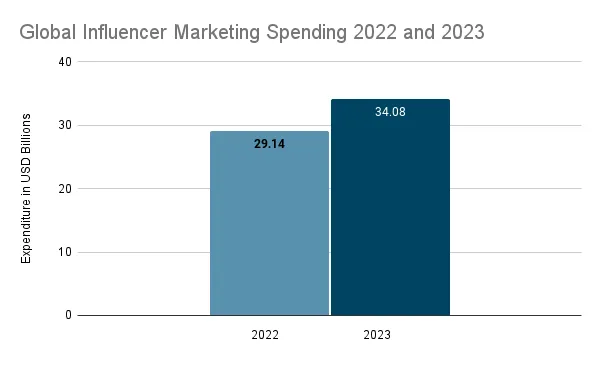
2. The global influencer market is valued at $21.1 billion USD
The popularity of influencer marketing worldwide cannot be understated. Millions of people are now browsing social media platforms daily in search of product recommendations. Marketers are taking advantage of the rapidly increasing number of social media users to increase brand exposure.
That explains why the global influencer marketing industry keeps growing in value and size. The industry was valued at approximately $21.1 billion USD as of December 2023.
3. The influencer market is expected to grow to $52 billion by 2028
According to Statista, the influencer advertising market valuation is expected to grow to approximately $35 billion USD in 2024. Additionally, the market is projected to maintain an upward trajectory at 10.36% annually up to a market volume of roughly $52 billion USD by 2028. This indicates a massive growth of the influencer industry in the coming years.
Influencer Marketing Advertising Statistics
At some point, we all have bought (or thought about buying) a product due to a recommendation from social media ads. This proves how much social media advertising has become integral to influencer marketing. Here are some of the stats you should note in influencer marketing advertising:
4. The global expenditure on influencer marketing advertising amounted to $34.08 billion USD in 2023, which was a higher figure than the projected $30.81
The $34.08 billion USD expenditure posted by the industry had a massive variation from the $30.81 billion USD expenditure projected by experts. This shows how much the industry is rapidly growing beyond expectations.
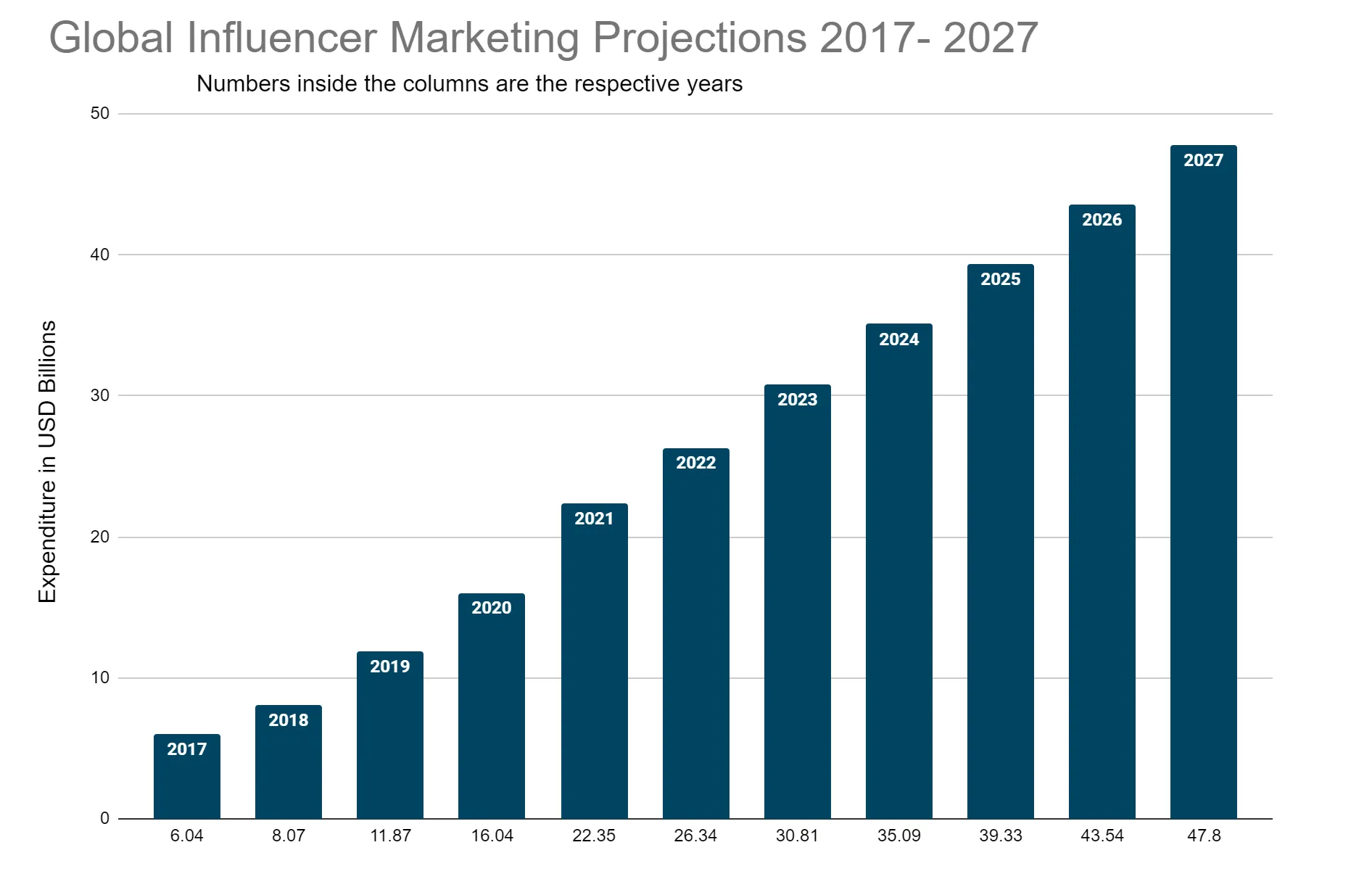
5. The average influencer marketing earned media value is $5.78 USD
Earned Media Value (EMV) is the amount of money (or value) your brand gains from social media content. According to Marketing Dive, businesses receive an average of $5.78 USD for every dollar spent on influencer marketing.
6. China spends the most on influencer marketing advertising
China’s influencer marketing ad spending is approximately $16.76 billion USD – the highest in the industry.
7. Instagram has the highest engagement rate for Nano Influencers
This is evident from the engagement rate statistics presented in the table below:
| Nano Influencer | Micro-Influencer | Macro Influencer | Mega Influencer | |
| Follower Count | 1,000 – 10,000 | 10,000 – 100,000 | 100,000 – 1,000,000 | 1,000,000+ |
| 5% | 3.5% | 2% | 1% | |
| 2% | 1.5% | 1.25% | 1% | |
| YouTube | 3.5% | 3% | 2% | 1.5% |
| TikTok | 18% | 12% | 8% | 4% |
| X (formerly Twitter) | 1% | 0.75% | 0.5% | 0.5% |
Influencer Marketing Statistics Based on Networks
It is also important to choose influencers that suit your brand. For instance, if you are a betting company, using retired athletes or a sports journalist as your marketing influencers makes more sense. The notion behind this is that such people tend to have a following that relates to sports and gambling.
Once you identify the preferred influencer for your brand, reach out to them and propose a deal. Most businesses usually go for transactions that involve a percentage commission on the sales. You can review the terms of the agreement over time as your business grows.
Influencers use several social media platforms to increase brand awareness – the average engagement rate, number of followers, and popularity of the influencers vary from platform to platform. This means that the number of users who follow through with the product recommendation from influencer campaigns also varies. Let’s dive deeper into the engagement metrics per platform.
8. Approximately 80.8% of marketers are more likely to use Instagram for influencer marketing
Are you wondering which platform is the best for influencer marketing campaigns? Instagram comfortably tops the influencer marketing platforms used by top and budding brands. The number of marketers who are likely to use Instagram for influencer marketing campaigns is projected to reach a record-high 80.8%!
This platform is the most popular influencer marketing platform among lifestyle brands. The top hashtags influencers use to maximize brand awareness include:
- #love (used 2.1 billion times)
- #instagood (used 1.7 billion times)
- #instagram (used 1.2 billion times)
- #fashion (used 1.1 billion times)
Instagram’s strength lies in its visual components – we are talking about the high-quality posts, reels, and stories that optimize influencer marketing campaigns.
9. 57% of marketers use Facebook for influencer marketing
Just like Instagram, Facebook is owned by Meta and is another darling among marketers. It is estimated that nearly 57% of marketers use Facebook for influencer marketing campaigns.
According to StrawPoll, the most popular hashtag on this platform is #foodporn, which is used by food enthusiasts and businesses to display their culinary prowess.
However, the many changes in the platform have resulted in a sharp decline in its organic reach. Despite Facebook being the most popular social media platform worldwide, there is not much influencer activity going on currently.
Regardless of the challenges impeding this platform, you can utilize the following features (other than the normal posts) to maximize your brand exposure:
- Livestreams – enjoy this feature by partnering with any top influencer suitable for your brand.
- Facebook stories (akin to Instagram stories) that appear at the top of Users’ feeds.
10. More than 55% of marketers use YouTube to promote brands
Ideally, when it comes to ads, the first thing that many people think about is YouTube. Before the advent of YouTube Premium or ad blockers (which impede ads from appearing when watching videos), we all complained about these ads. We didn’t know back then that this was just an attempt by marketers to get us to purchase the products or services advertised.
Do you know that over 55% of marketers use YouTube to market products? Some of the most popular hashtags on this platform are:
- #beauty (used over 100 million times)
- #food (used over 70 million times)
- #travel (used over 50 million times)
- #fitness (used over 30 million times)
Maybe the click-through rate isn’t as high as the other platforms because these ads often interrupt users’ video viewing sessions, and most people don’t like it. This is different from how the other platforms show their ads – for Instagram, Facebook, and TikTok, you don’t have to watch any ad for you to view posts.
11. TikTok’s engagement rate for nano influencers is 18%
The emergence of TikTok in influencer marketing was a game-changer. This platform’s popularity exploded overnight and has specific demographics and reach – we are talking about its chokehold on Gen Z users.
The Engagement Rate on TikTok sits at a stunning 18% for nano influencers, trampling giants like Instagram (5%) and YouTube (3.5%). This means that brands that have successfully adopted influencer campaigns can thrive on this platform.
12. 25.9% are more likely to rely on X (formerly Twitter) for influencer marketing
The evolution of X (formerly Twitter) in Influencer marketing has resulted in many marketers running influencer campaigns on the platform. The estimated number of brands projected to use this platform is 25.9%.
Unlike other platforms, the trending hashtags on X (Twitter) change daily. It is estimated that people tweet close to 125 million hashtags daily and that the most popular hashtags on a particular day can help increase brand awareness.
With the revolutionary changes proposed by Elon Musk, we could see the number of influencer campaigns going even higher in the coming years. Some of the new X features that have been introduced are:
- An increase in tweet (characters) and video (minutes) length.
- Enhanced media sharing capabilities.
- Twitter Space.
13. Nearly 70% of consumers would rather read blogs than watch ads
Influencer blogging has become a popular form of online marketing due to the rapid increase in social media use globally. It is a powerful tool that you can utilize to build your brand and reach a larger audience. Statistics indicate that 70% of consumers prefer reading blogs to watching ads. This means that influencer blogging has a great potential to maximize your engagement rate compared to other influencer marketing platforms.
The way influencer bloggers connect and appeal to their followers can tremendously increase your brand exposure in ways that traditional advertising methods can’t.
The influencers craft and share blogs that extensively highlight their experiences, lifestyles, and opinions on your products(s) or service(s). Since they have a loyal follower base who trust their recommendations, you’ll get to achieve your business goals.
14. LinkedIn is the most popular B2B influencer marketing platform
Have you ever heard of B2B influencer marketing? It is totally different from the typical influencer marketing that many people know (business to consumer). B2B influencer marketing deals with a whole different audience – we are talking about potential hires, investors, and prospects.
LinkedIn is a powerful social platform that has proven to be super useful in B2B influencer marketing – it is the most appealing to the targeted audiences. Additionally, B2B influencer marketing campaigns are estimated to have an impressive engagement rate of 8.7%. This is because the influencers on LinkedIn are highly respectable companies with proven credibility among their followers.
15. Twitch experiences more than 15 million active users daily
Many people do not know that this platform has existed for nearly 13 years but has recently gained global popularity. Twitch’s popularity is attributed to live streaming and video gaming. It is also a go-to social media platform for influencers across diverse industries. Who wouldn’t want to use a platform with over 15 million active users daily? Plus, users on this platform get hooked for nearly 95 minutes just watching live content daily.
Influencer Marketing Statistics for Fashion and Beauty
The fashion and beauty influencer marketing sector stands out amongst other verticals.
16. Projections indicate that the fashion and beauty sector will grow up to $6.17 billion USD in 2024
The sector’s market size is projected to grow from $4.55 billion USD in 2023 to roughly $6.17 billion USD in 2024 – a CAGR of 35.7%.
17. The estimated value of the fashion and beauty influencer marketing sector is $30.4 billion USD by 2032
Insights indicate that the value of the fashion and beauty influencer marketing sector could reach a stunning $30.4 billion USD by 2032. The estimated exponential growth is credited to the ever-increasing use of social media, brand collaborations, global accessibility and reach, and consumer behavioral changes.
Influencer Marketing Statistics for Food and Beverage
Food and beverage is a diverse influencer marketing market – there is a category that cooks and shares recipes on camera, foodies who just try out local cuisines, and another category that basically records their meals. Many restaurants have partnered with food and beverage influencers to drive awareness, sales, and traffic for their products and services.
18. The #foodcontent hashtag has over 700 million views on TikTok
With food-related content spiraling in most social media spaces, especially TikTok and Instagram, businesses are trying to capitalize on this hype. The #foodcontent hashtag has garnered more than 700 million views on TikTok alone! It is estimated that about 86% of Gen Z are willing to try out restaurants or recipes they encounter online. This could massively transform the food and beverage influencer marketing sector.
Influencer Marketing Budget Statistics
What is the influencer marketing budget worldwide? Many companies are now budgeting more for influencer marketing than traditional advertising. Let’s take a closer look at the influencer marketing budget statistics.
19. Global Spending Trends
The increasing number of daily active social media users means that companies and brands allocate more of their marketing budget to influencer marketing. Here is a breakdown of how brands globally budget for influencer marketing:
- 25% of brands spend 10 – 20% of their marketing budget on influencer marketing efforts.
- 23% of brands give 40% or more of their marketing budget to influencers.
- 20% of brands allocate less than 20% of their marketing budget to influencer marketing.
- 18% of brands spend 20 – 30% of their marketing budget on influencers.
- 13% of brands focus 30 – 40% of their marketing budget on influencer marketing.
20. Budget Distribution Channels
Every social media channel has numerous influencers – you need to be financially prepared upfront before partnering with influencers. Here is a list of influencer categories and their costs to help you know how much you should spend on influencer marketing:
- Nano influencers cost up to $250 USD per post.
- Micro-influencers will charge you up to $1,250 USD per post.
- Power influencers cost up to $12,500 USD per social media post.
- Macro-influencers can charge you up to $25,000 USD per social media post.
- Mega influencers charge in excess of $1 million USD per post.
Fuel Your Marketing Strategy with These Statistics
You should remember to manage your expectations. Avoid being overconfident in your campaigns – treat them as a profit or loss situation.
Still, the statistics highlighted in this article can be a game-changer for your brand if you want successful influencer marketing campaigns. All you need to do is select the right influencer(s), strike a deal, monitor your campaigns, and keep up with industry changes!
